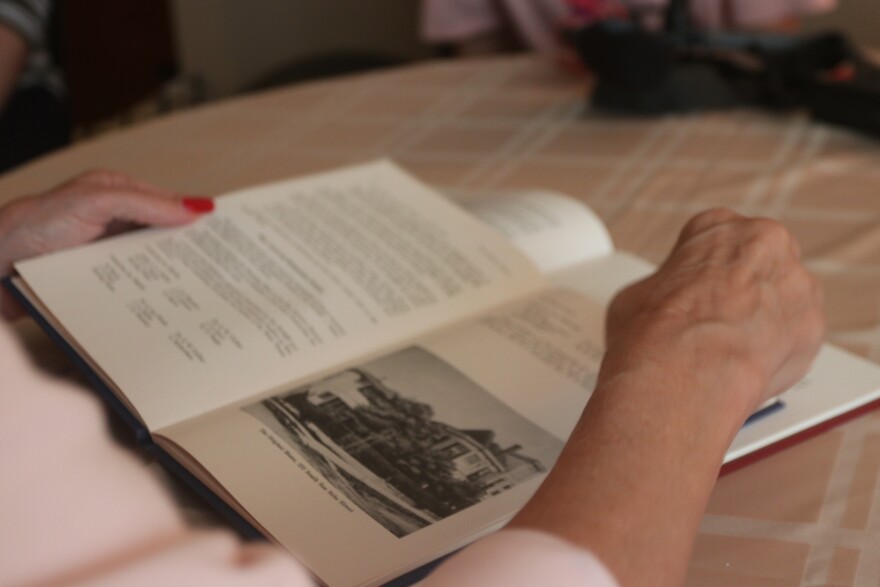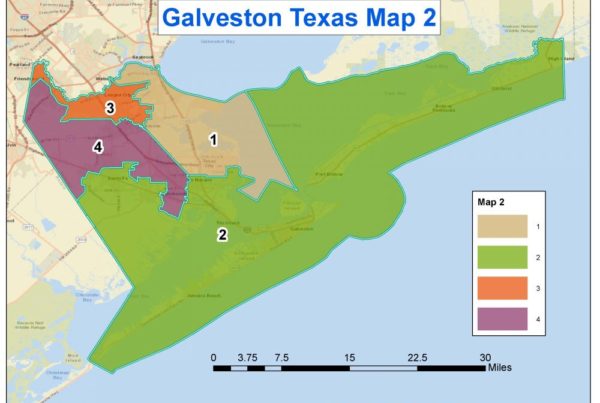From Texas Public Radio:
This story is part of a series from Texas Public Radio called “Running Red-Lights.” The podcast and additional reporting focuses on the history of sex work in San Antonio and the women who ran the industry, but who weren’t allowed to make history.
The first time Evan Jones heard about Mary Volino was in a United Methodist confirmation class in 1989.
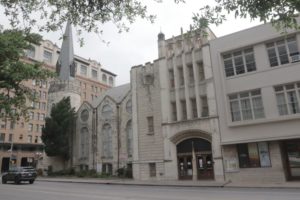
Travis Park Church is located in the center of downtown San Antonio. According to its history, a brothel owner once heard one of the church’s street preacher’s and decided to convert to the faith.
She was a well-known and successful madam of a San Antonio brothel in the late 19th century. One day, she decided to change her business into a rescue home. Travis Park Church — where Jones was confirmed — teaches her story as a part of its history to demonstrate the power of religious faith, Jones said.
Yet for years, the church didn’t even know Volino’s first name. All they had was an initial.
It wasn’t until Jones — a former member of the church — earned his master’s degree in theology from the Perkins School of Theology at Southern Methodist University. One of his final projects was simple: write a paper about any topic in United Methodist history.
“I was in my last semester of seminary and I was done like, I was ready to be out. So to be very honest, if we’re all going to be real honest, my goal was to write the easiest four-page paper you could ever imagine and just be done with this class,” he said.
He thought back to his experience in the church, and he remembered the story he was taught about a brothel-owner who was saved by the church.
The original intent was to figure out her first name. In the decades of telling this story, the church only referred to Volino as M. or M.L. Volino. Jones turned to Bexar County Court records and almost immediately found her. She had been arrested for prostitution.

Evan Jones is a former member of Travis Park Church. He first heard the story of Mary Volino’s conversion in confirmation class in 1989, and he later went on to research more about her story when he was in seminary school.
But once he found her name, Jones wanted to know more about Volino. He discovered a new detail he had never been taught: Volino was in serious debt.
There are actually two versions of the Mary Volino story Jones heard growing up. The first is the one he heard in his confirmation class that had been passed down for generations: A madam of a large brothel heard a street preacher and attended a revival at Travis Park Church the following day, where she confessed Jesus Christ as her Lord and Savior, and then converted her brothel into a home for “wayward” women.
In the other story, her conversion was made possible by a member of the congregation, a woman named Sarah Ostrom.
Ostrum had already forged a friendship with Volino and encouraged her to attend the revival. This telling of the story is where Jones says he might get in trouble as a member of the clergy.
“The truth of the matter is in the Methodist Church, the power is with the laity, the power is with the people, not with the clergy,” he said. “Clergy people can be the leaders of the institution, can be the leaders in worship, can be the preachers. But really, when a church is effective, the laypeople are the ones that are doing the work of the Kingdom of God.”
Jones contends the loss of her daughter brought her to grief — and later, to God.
He also acknowledged a possible third version of this story. A madam of a large brothel is in significant debt. The church offers to clear her of that debt and is granted ownership of the house.
“That was the church’s kind of tentacles into the ministry was they had a financial stake in it, which can be bad and good. I think it allowed her to be debt free and live in a different way,” Jones said.
No matter the version of the story, some details are certain: Her once-lucrative brothel put her into debt. Jones isn’t exactly sure how she got into so much debt, but she owed nearly $6,000 according to Bexar County Clerk deed records.
Once the home was converted, it housed between 20-30 women, and by the turn of the century, there were more than 60 women in the home. The women cooked and cleaned for the others who lived and worked at the home and were given schooling lessons and job training to prepare for their departure from the home.
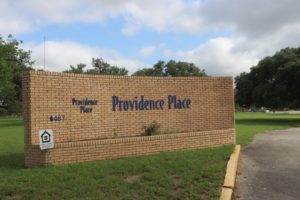
Providence Place was originally called Methodist Mission Home and was created in the late 1800s when Travis Park Church
The home still exists today, though its name has changed. Once Methodist Mission Home, it’s now called Providence Place.
“We were that place that most people would call Aunt Jane or Aunt Susan, where families sent their pregnant daughter to live, have the baby and then go back home,” said CEO Judith Bell.
Providence Place has gone through a series of focus-shifts — from adoption agency in the early 19th century to serving the local Deaf and hard-of-hearing community. Its current CEO Judith Bell said the organization is now returning to its roots, the roots Volino planted more than a century ago.
“Our main focus is on trauma-informed care and meeting the women where they are. No judgment, just meeting where they are, developing a place where they can take a rest. Then pause, you know, take a deep breath and then start on their restoration journey,” she said.
Providence Place serves women in a transitional housing program, focusing on survivors of assault, domestic violence and human trafficking. They also have a program for young women who are aging out of the foster care system but have elected to stay in extended foster care and for women who are unsheltered, Bell said.
Right now, they have the capacity to care for about 40 women, including pregnant women or women with children. Bell said she thinks Volino would be proud of how the mission has grown, despite whether the conversion was real.
“Every time I tell this story, inevitably someone comes up to me and says, ‘I was adopted for a Methodist Mission Home’ or ‘I adopted my kid from Methodist Mission Home’ or some version of that story,” Jones said.
Pre- “conversion”
Jones speculates that Volino — née Burns — was born between 1848-1851, but there is no hard evidence.
She married twice. First to Peter Burns, and together they had a daughter named Gracia. Both Peter and Mary were active in the red-light district: they owned several properties throughout the later 1870s. He disappeared in court records after about 1880, and Gracia died young, Jones said. The circumstances of either of their deaths is unknown.
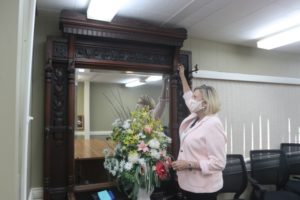
Judith Bell points out a hat rack, which was originally placed at the front door of Madam Mary Volino’s brothel. It’s one of few surviving pieces from the original Methodist Mission Home, according to Bell.
Then she was married to Mike Volino, an Italian immigrant with whom she had her second (known) child, William, who also died young. Mike was a musician, who played with his brothers in the bars and saloons of the red-light district. Jones said this is likely how they met.
Mike bought property in the area, and together they operated a saloon.
But even before Mary met Mike in the early 1880s, she had already been working under the alias Madam Claude Duval and was one of the most successful brothel owners at the time.
She met her mentor and former madam, Blanche Deerwood, around 1877. She “boarded” in Deerwood’s house. They remained friends even as Mary became competition.
She operated under several names as a madam in San Antonio’s Red-Light District: her birth name, Mary L. Burns; her first alias, Claude Duval; Mary A. Palmer; Mary Volino.
She bought her infamous brothel at 223 San Saba. It was a two-story mansion with over 32 rooms, Jones notes in the final paper he submitted. Though was one of the most successful in San Antonio’s red-light district, she accrued $6,000 of debt
Post- “conversion”
In his research, Jones found that the church almost immediately started hosting worship services for the girls and women of the home after settling Volino’s debt. Some of the women who worked under Volino continued their work at other brothels when her house became a rescue home, but others stayed.
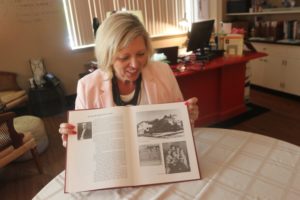
Judith Bell, CEO and President of Providence Place, presents a photo of the original Methodist Mission Home.
Volino acted as the matron of the home. She cared for the women there and secured donations — likely the same men she once did business with, Jones said.
The numbers of women cared for at the home grew quickly in its first few years, but by 1904, Volino was preparing to leave San Antonio. She quickly sold off her property and assets, and then, she disappeared from Bexar County court records.
“For 100 years, no one really knew where she went,” Jones said. In his research process, Jones tracked her down to Provence, Oklahoma, an up-and-coming boomtown.
Jones had used findagrave.com to find her. It’s a grassroots website where people post pictures of headstones. When he first searched “Volino” and found a headstone in Oklahoma, he’d ignored it because he was focused on finding her in Texas.
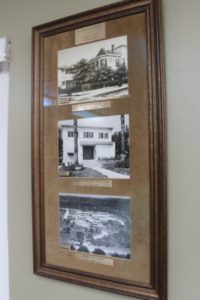
Providence Place, formerly called Methodist Mission Home, was originally located downtown on San Saba (top). Before moving to its current location off Whitby Road (bottom), the organization operated at a Baylor Scott Hospital location in the 1960s (center).
Looking at findagrave.com again, Jones realized the number of headstones with the last name “Volino” lined up with the number of Volinos he expected there to be, even though he didn’t see a headstone for a Mary Volino.
So, he drove up to Oklahoma, where he found Volino’s great niece.
“I was so nervous, like, I couldn’t believe that I was sitting in front of someone that not only had a direct connection with (Volino), but lived with her like in the same house, lived with her,” he said.
Volino’s niece, Virginia, was her husband’s brother’s wife’s child. The family never spoke about Mary Volino after an incident in the family involving money.
“Virginia’s mom, Sallie, told the kids that Mary, quote, ‘took all the money from us kids.’ And so, Virginia was not real excited to have a conversation with me,” he said.
Jones said on top of the family drama, the interview was awkward because Virginia didn’t know about Mary’s life as a madam. Though Virginia was reluctant to talk about it, another family member — who Jones said acted as a sort of advocate — encouraged her to help document their family’s history.
When Jones left Virginia’s home, he realized he had never hit “record” on his recorder.
Virginia died a week after their conversation.
There are few solid facts in the life of Mary Volino. We’re not sure when or where exactly she was born. We’re not sure why she decided to move to Provence. We also don’t know why she left.
The last documentation of Volino is in the 1920 Census; she’s listed as 71 years old.
There is no evidence that Volino stayed a member of the Travis Park Church congregation after her so-called conversion. Jones said she doesn’t appear on any membership rolls, which doesn’t prove she wasn’t a member necessary. There’s just no proof.
There was no funeral for Volino when she died, nor does she have a proper headstone. Her great niece, Virginia, told Jones she is buried in Provence Cemetery, where there is a deteriorated marker with no name on it.
Volino is one of many madams who made San Antonio’s red-light district successful and whose histories were not preserved. Unlike the others, some of her legacy is remembered through institutions like Providence Place and Travis Park Church.


